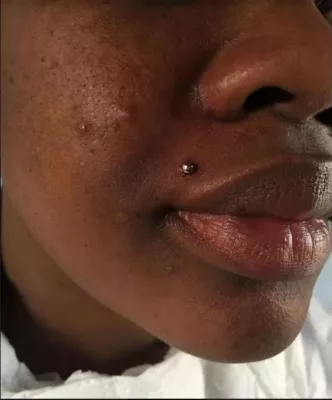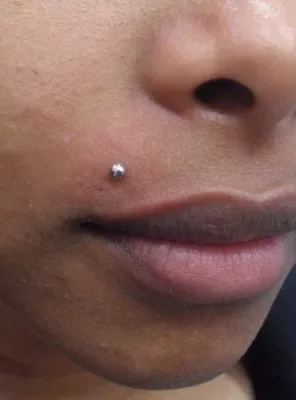Monroe Piercing in Nairobi, Kenya
(Variations, Pain Threshold, Healing Time, Aftercare Tips, and Jewelry Guide)
The Monroe piercing is a type of facial piercing that is placed on the upper lip, on the left or right side. It is a type of labret piercing, which means it is done on the lower lip or the area surrounding the lips.
The procedure involves puncturing a hole through the skin of the upper lip, which is usually done using a hollow needle. The piercer will then insert jewelry, such as a stud or a hoop, into the hole.

Monroe Piercings
Like with any piercing, there are risks associated with getting a Monroe piercing, such as infection, swelling, bleeding, and scarring. It is important to choose a reputable piercer who follows proper hygiene and safety protocols.
After getting a Monroe piercing, it is important to follow proper aftercare instructions, such as cleaning the piercing regularly with saline solution, avoiding touching or twisting the jewelry, and avoiding certain activities, such as kissing or smoking, that can irritate the piercing.
Monroe Piercing Variation
While the classic Monroe piercing is typically placed on the upper lip, to the left or right of the center of the lip, there are several variations of this piercing that can be done. Some of these variations include:
- Double Monroe Piercing: Two Monroe piercings are placed on the upper lip, either on the same side or on opposite sides.
- Vertical Labret Piercing: A vertical labret piercing is similar to a Monroe piercing but is placed on the lower lip, with the jewelry going up through the bottom of the lower lip and exiting at the top of the upper lip.
- Medusa Piercing: A Medusa piercing is also similar to a Monroe piercing but is placed in the center of the upper lip, rather than to the left or right.
- Dahlia Piercing: A Dahlia piercing is done on the corners of the mouth, with the jewelry exiting through the skin at the corners of the mouth.
- Ashley Piercing: An Ashley piercing is placed in the center of the lower lip, with the jewelry exiting through the skin at the center of the upper lip.
It is important to note that all piercings carry some degree of risk, and it is important to choose a reputable piercer who follows proper hygiene and safety protocols and to follow proper aftercare instructions to ensure proper healing and minimize potential complications.
Considerations before getting a Monroe Piercings
Getting a Monroe piercing or any facial piercing is a personal decision, and it’s essential to consider several factors before going through with the procedure. Here are some important considerations:
Piercing Studio Selection:
- Research reputable piercing studios in your area. Ensure they have experienced and capable piercers.
- Check online reviews and ask for recommendations from friends who have had piercings.
- Visit the studio in person to assess its cleanliness, professionalism, and adherence to safety standards.
Piercer Qualifications:
- Verify the piercer’s qualifications, including their capability and experience with facial piercings.
- Feel free to ask questions about their sterilization procedures and how they handle aftercare guidance.
Jewelry Selection:
- Discuss the type of jewelry you want with your piercer. Quality jewelry made from materials like surgical steel, titanium, or biocompatible plastics is recommended.
- Consider the size and style of the jewelry, ensuring it suits your facial anatomy and personal preferences.
Placement:
- Discuss the exact placement of the Monroe piercing with your piercer. It should be positioned where you desire it and where it complements your facial features.
Pain Tolerance:
- Be prepared for some discomfort during and after the piercing process. Pain tolerance varies from person to person, but most people find it manageable.
Healing Time and Aftercare:
- Understand that Monroe piercings typically take 6 to 10 weeks to fully heal.
- Commit to following the aftercare instructions provided by your piercer, which typically include cleaning the piercing with saline solution and avoiding touching it with dirty hands.
Lifestyle Considerations:
- Think about how the piercing may affect your daily life, including eating, speaking, and sleeping. Initially, there may be some discomfort and adjustments needed.
Infection and Complications:
- Be aware of the potential risks, including infection, rejection, or allergic reactions to the jewelry.
- Pay attention to any signs of infection, such as excessive redness, swelling, pain, or discharge, and seek prompt medical attention if you suspect a problem.
Commitment:
- Consider the long-term commitment to the piercing. Removing it may result in some scarring or visible hole closure.
Professional and Social Implications:
- Evaluate how a facial piercing may affect your professional and social life, especially if you work in a conservative environment or have strict dress code policies to adhere to.
Allergies:
- If you have known allergies or sensitivities to certain metals or materials, discuss this with your piercer to select suitable jewelry.
Personal Style:
- Ensure that a Monroe piercing aligns with your personal style and aesthetic preferences.
Remember that body modification choices, including piercings, are personal expressions of individuality. Take the time to make an informed decision and prioritize safety throughout the process. It’s also a good idea to consult with your piercer about any specific concerns or questions you may have before proceeding with a Monroe piercing.


OUR LOCATION
Areas We Serve
NAIROBI
KIAMBU
KAJIADO
MACHAKOS

